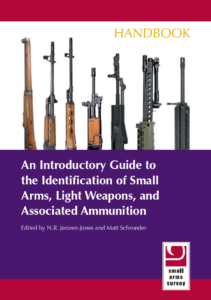Arms and ammunition are evidence. Many weapons carry marks that, combined with their physical characteristics, reveal important information about them, including their manufacturer, age, and origin. This information, in turn, provides vital clues about the sources and flows of weapons in the area in which they were found.
ARES personnel have worked with the Small Arms Survey to produce a new Handbook introducing readers to the identification of small arms, light weapons, and associated ammunition. ARES Director N.R. Jenzen-Jones served as lead author on six of the nine chapters, as well as the SALW subject matter expert and co-editor for the publication. ARES Technical Specialists Jonathan Ferguson and Anthony G. Williams also served as authors on chapters, and many other ARES staff and consultants played important roles. The ARES team was supported by knowledgeable and dedicated colleagues at the Small Arms Survey.
The goal of the Handbook is to provide the reader with a basic understanding of how to identify and analyse small arms and light weapons, and to track their proliferation. The process of identifying arms is complex, and no single guide can provide all of the information required to identify every weapon or round of ammunition that may be encountered at crime scenes or in conflict zones. Instead, this guide explains the process by which weapons and ammunition are identified and arms flows are tracked. Reference material on specific small arms, light weapons, and ammunition is included throughout the guide. This material will help readers to take the steps necessary to identify the make and model of the most commonly encountered weapons and ammunition.
Director Jenzen-Jones said:
This has been a labour of love which has unfolded over several years. Whilst there were hurdles along the way, I believe that the end product is exceptional and will play a critical role in helping researchers, investigators, law enforcement and intelligence officials, journalists, and others in conducting their important tasks. It will also serve as a useful reference guide for historians, collectors, and enthusiasts.
I am now particularly eager to get this new resource into the hands of practitioners. It is my hope this will get more of us ‘on the same page’.
The Handbook consists of nine chapters, and other material, as follows:
- Preliminary pages
- Chapter 1 – Small Arms Identification: An Introduction
- Chapter 2 – Understanding the Trade in Small Arms: Key Concepts
- Chapter 3 – Weapons Identification: Small Arms
- Chapter 4 – Weapons Identification: Small-calibre Ammunition
- Chapter 5 –Weapons Identification: Light Weapons and their Ammunition
- Chapter 6 – Weapons Identification: Other Small Arms and Light Weapons
- Chapter 7 – Gathering Arms and Ammunition Data in the Field: Advice for Researchers
- Chapter 8 – Analysing Arms Flows: Authorized Transfers
- Chapter 9 – Analysing Arms Flows: Illicit Weapons
- Bibliography
The Handbook draws extensively on ARES research into the topics at hand, including a set of definitions of SALW that ARES has developed, our Arms & Munitions Classification System (ARCS), our proprietary Conflict Materiel (CONMAT) Database, and dozens of publicly-available and confidential reports. Many of these ‘component parts’ of the Handbook are available to selected clients.
Do you have questions regarding identifying, classifying, or defining SALW or other arms & munitions? Contact us.
Remember, all arms and munitions are dangerous. Treat all firearms as if they are loaded, and all munitions as if they are live, until you have personally confirmed otherwise. If you do not have specialist knowledge, never assume that arms or munitions are safe to handle until they have been inspected by a subject matter specialist. You should not approach, handle, move, operate, or modify arms and munitions unless explicitly trained to do so. If you encounter any unexploded ordnance (UXO) or explosive remnants of war (ERW), always remember the ‘ARMS’ acronym:
AVOID the area
RECORD all relevant information
MARK the area from a safe distance to warn others
SEEK assistance from the relevant authorities





2 thoughts on “New Handbook: An Introductory Guide to the Identification of Small Arms, Light Weapons, and Associated Ammunition”